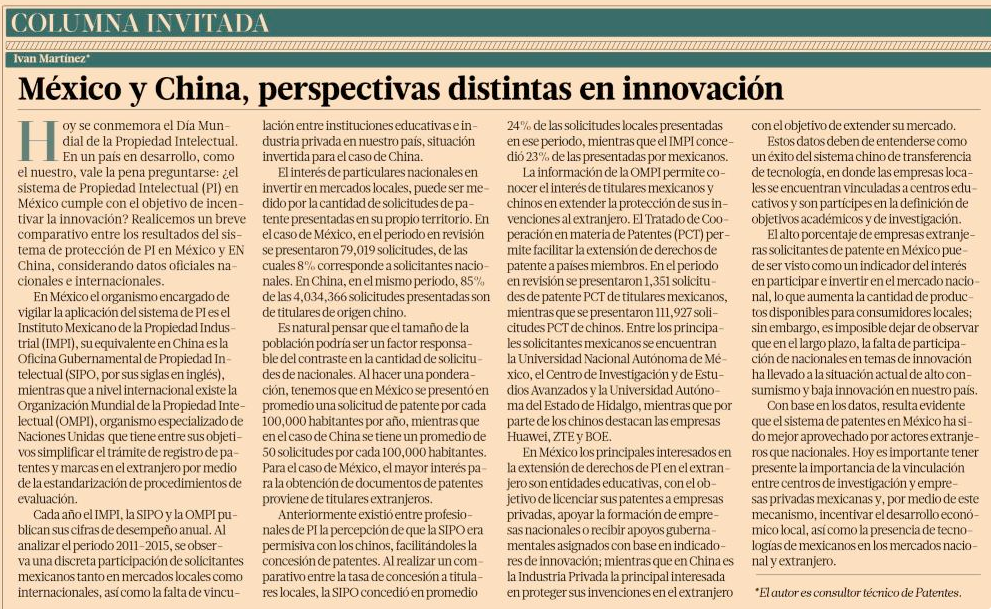Mexico and China, different perspectives on innovation
- 08 May 2017
- Articles
April 26 marks the World Intellectual Property Day commemoration, in a developing country like ours it is worth asking: does the Intellectual Property (IP) system in Mexico meet the objective of encouraging local innovation? Let us make a brief comparison between the Mexican and Chinese IP system results
In Mexico, the Instituto Mexicano de la Propiedad Industrial (IMPI) is responsible for overseeing the IP system application, its equivalent in China is the State Intellectual Property Office of the P.C.R. (SIPO), in the other hand, the World Intellectual Property Organization (WIPO) is a specialized agency of the United Nations which has among its objectives the simplification of patents and trademarks registration by means of the standardization of evaluation procedures.
Annually the IMPI, SIPO and WIPO publish a performance report, when analyzing 2011-2015 period we found a low participation of Mexican applicants in both local and international markets, as well as the lack of linkage between educational institutions and private industry in Mexico, a situation reversed in China.
The interest of local applicants in their markets can be measured by the number of patent applications filed by them in their own country, in Mexico during the period under review 79,019 applications were filed, from which 8% correspond to National applicants. In the same period in China 85% of the 4,034,366 applications were filed by Chinese applicants.
It is natural to think that population size could be a factor responsible for the contrast in the number of national local applications, however, when considering this factor we have that in Mexico it was filed an average of one patent application per 100,000 inhabitants per year, while in China there was an average of 50 applications per 100,000 inhabitants per year. In Mexico, the greatest interest for filing patent documents comes from foreign applicants.
The information published by the WIPO allows the measure of Mexican and Chinese holders interest in extending the protection of their inventions abroad. The Patent Cooperation Treaty (PCT) facilitates the extension of patent rights to member countries. In the period under review, 1,351 PCT patent applications were filed by Mexican holders, while 111,927 PCT applications from Chinese holders were filed. Among the main Mexican applicants are educational and research centers like UNAM, CINVESTAV and UAEH, while from the Chinese applicants are highlighted companies like Huawei, ZTE and BOE.
The main Mexican entities interested in IP rights extension are educational and research centers with the aim of licensing their patents to foreign companies, supporting the creation of new local companies or receiving government support; while in China the private companies are interested in extending their inventions protection looking for expansion in new markets.
These data shows the success of Chinese technology transfer system where local enterprises are closely linked to educational centers and are involved in the definition of academic and research objectives.
The high percentage of foreign patent filings in Mexico could be seen as an indicator of the participation and investment of international companies in the Mexican market, this interest increases the amount of products available to local consumers. However, in the long term the low participation of local companies in innovation has led to the current situation of high consumerism and low innovation.
Considering the results obtained, it is evident that the patent system in Mexico has been better exploited by foreign applicants.
On April 26, it is important to keep in mind the importance of research centers and Mexican private companies linkage, because through this mechanism it is possible support our local economic development as well as the presence of Mexican technologies in local and foreign markets.











